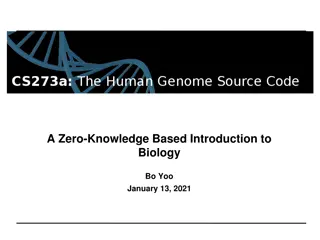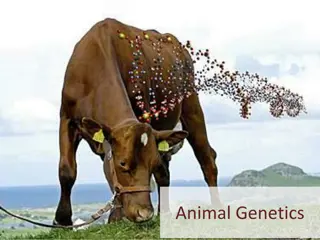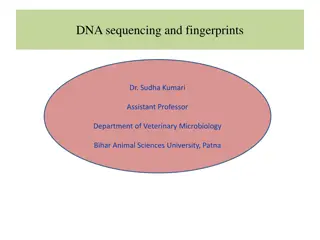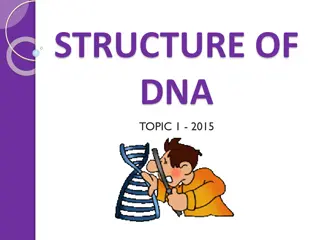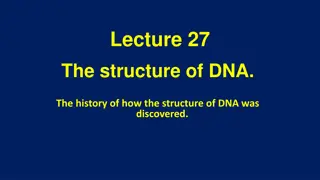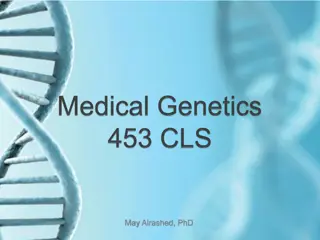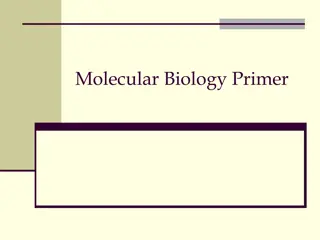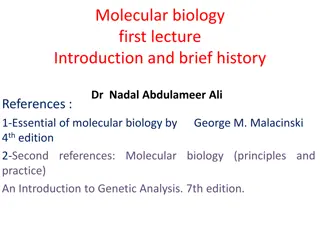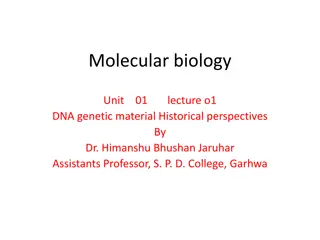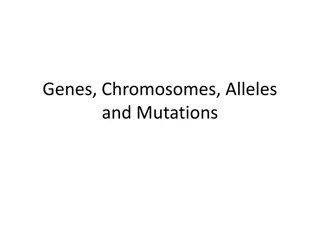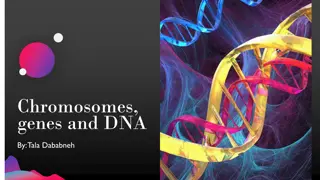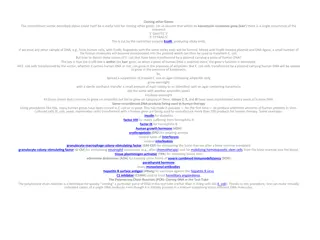Understanding DNA: A Journey from Friedrich Miescher to Genes and Function
DNA, the hereditary basis of life, was first discovered by Friedrich Miescher in 1869. It consists of chromosomes, plasmids, and organellar DNA, collectively known as the genome. Genes, sequences of DNA, encode proteins and RNA, essential for an organism's functions. The genome is divided into chromosomes, each containing numerous genes, crucial for storing and transmitting biological information. Ribosomal RNAs, messenger RNAs, and transfer RNAs are different classes of RNAs with diverse functions in protein synthesis.
Download Presentation

Please find below an Image/Link to download the presentation.
The content on the website is provided AS IS for your information and personal use only. It may not be sold, licensed, or shared on other websites without obtaining consent from the author. Download presentation by click this link. If you encounter any issues during the download, it is possible that the publisher has removed the file from their server.
E N D
Presentation Transcript
DNA INTRODUCTION
Friedrich Miescher in Germany, 1869 Isolated nuclei from pus cells (white blood cells) in waste surgical bandages The nuclei contained a novel phosphorus bearing substance that he named nuclein It is mostly chromatin which is a complex of DNA and chromosomal proteins
Genome The heriditary basis of every living organism is its genome, a long sequence of DNA that provides the complete set of heriditary information carried by the organism. It includes Chromosomal DNA DNA in Plasmids Organellar DNA as found in mitochondria and chloroplasts (in Eukaryotes) By a complex series of interactions the DNA sequence produces all of the proteins of the organism at the appropriate time and place.
A plasmid is a DNA molecule that is separate from, and can replicate independently of, the chromosomal DNA They are double stranded and, in many cases, circular. Plasmids usually occur naturally in bacteria, but are sometimes found in eukaryotic organisms (e.g., the 2-micrometre- ring in Saccharomyces cerevisiae).
Physically the genome may be divided into a number of different DNA molecules, or CHROMOSOMES. So genome is the sequence of DNA of each chromosome Functionally a genome is divided into genes
The amino acid sequence of every protein in a cell, and the nucleotide sequence of every RNA, is specified by a nucleotide sequence in the cell s DNA. A segment of a DNA molecule that contains the information required for the synthesis of a functional biological product, whether protein or RNA, is referred to as a gene. or Each gene is a sequence of DNA that encodes a single type of RNA or polypeptide A cell typically has many thousands of genes, and DNA molecules, not surprisingly, tend to be very large. 500 genes (mycoplasma, a type of bacterium) 20,000-25,000 (humans) 50,000-60,000 (for rice) Functions: The storage and transmission of biological information are the only known functions of DNA.
RNAs have a broader range of functions, and several classes are found in cells. Ribosomal RNAs (rRNAs) are components of ribosomes, the complexes that carry out the synthesis of proteins. Messenger RNAs (mRNAs) are intermediaries, carrying genetic information from one or a few genes to a ribosome, where the corresponding proteins can be synthesized. Transfer RNAs (tRNAs) are adapter molecules that faithfully translate the information in mRNA into a specific sequence of amino acids.
DNA is the Genetic Material Transformation Fredrick Griffith 1928 The bacterium Streptococus (formerly Pneumococcus) Pneumonia kills mice by causing Pneumonia Virulence is determined by capsular polysaccharide of bacterium which allows bacterium to escape destruction by its host Several types of S. pneumoniae have different polysaccharides but they all have a smooth appearance Each of the S type can give rise to variant that fail to produce the capsular polysaccharide and therefore have a rough surface(R) R types are avirulent and do not kill the mose Heat killed S type bacteria are also avirulent Heat killed S type bacteria and R type avirulent bacteria when injected jointly cause pneumonia and mouse died S type virulant bacteria were recovered from the blood Some property of dead bacteria has transformed the avirulent bacteria and make them virulent
Oswarld Avery, Maclyn McCarty, and Colin MacLeod (1944) Performed the same experiment, only they used tissue cultures growing in petri dishes
FIGURE The Avery-MacLeod-McCarty experiment. (a) When injected into mice, the encapsulated strain of pneumococcus is lethal,(b) whereas the nonencapsulated strain, (c) like the heat-killed encapsulated strain, is harmless. (d) Earlier research by the bacteriologist Frederick Griffith had shown that adding heat-killed virulent bacteria (harmless to mice) to a live nonvirulent strain permanently transformed the latter into lethal, virulent, encapsulated bacteria. (e) Avery and his colleagues extracted the DNA from heat-killed virulent pneumococci, removing the protein as completely as possible, and added this DNA to nonvirulent bacteria. The DNA gained entrance into the nonvirulent bacteria, which were permanently transformed into a virulent strain.
Avery and his colleagues concluded that the DNA extracted from the virulent strain carried the inheritable genetic message for virulence. Not everyone accepted these conclusions, because protein impurities present in the DNA could have been the carrier of the genetic information. This possibility was soon eliminated by the finding that treatment of the DNA with proteolytic enzymes did not destroy the transforming activity, but treatment with deoxyribonucleases (DNA-hydrolyzing enzymes) did.
. Hershey and Chase Experiment A second important experiment provided independent evidence that DNA carries genetic information. In 1952 Alfred D. Hershey and Martha Chase used radioactive phosphorus (32P) and radioactive sulfur (35S) tracers to show that when the bacterial virus (bacteriophage) T2 infects its host cell, Escherichia coli, it is the phosphorus-containing DNA of the viral particle, not the sulfur-containing protein of the viral coat, that enters the host cell and furnishes the genetic information for viral replication (Fig. 8 13). These important early experiments and many other lines of evidence have shown that DNA is the exclusive chromosomal component bearing the genetic information of living cells
When DNA is entered in cells growing in culture, it enters the cells, and in some of them it results in the production of new proteins The DNA that is introduced into the recepient cell becomes the part of its genome and is inherited with it Expression of the new DNA results in a new trait Indicate that DNA is the genetic material in eukaryotes All known organisms and some viruses has DNA as genetic material Some viruses use RNA as genetic material



